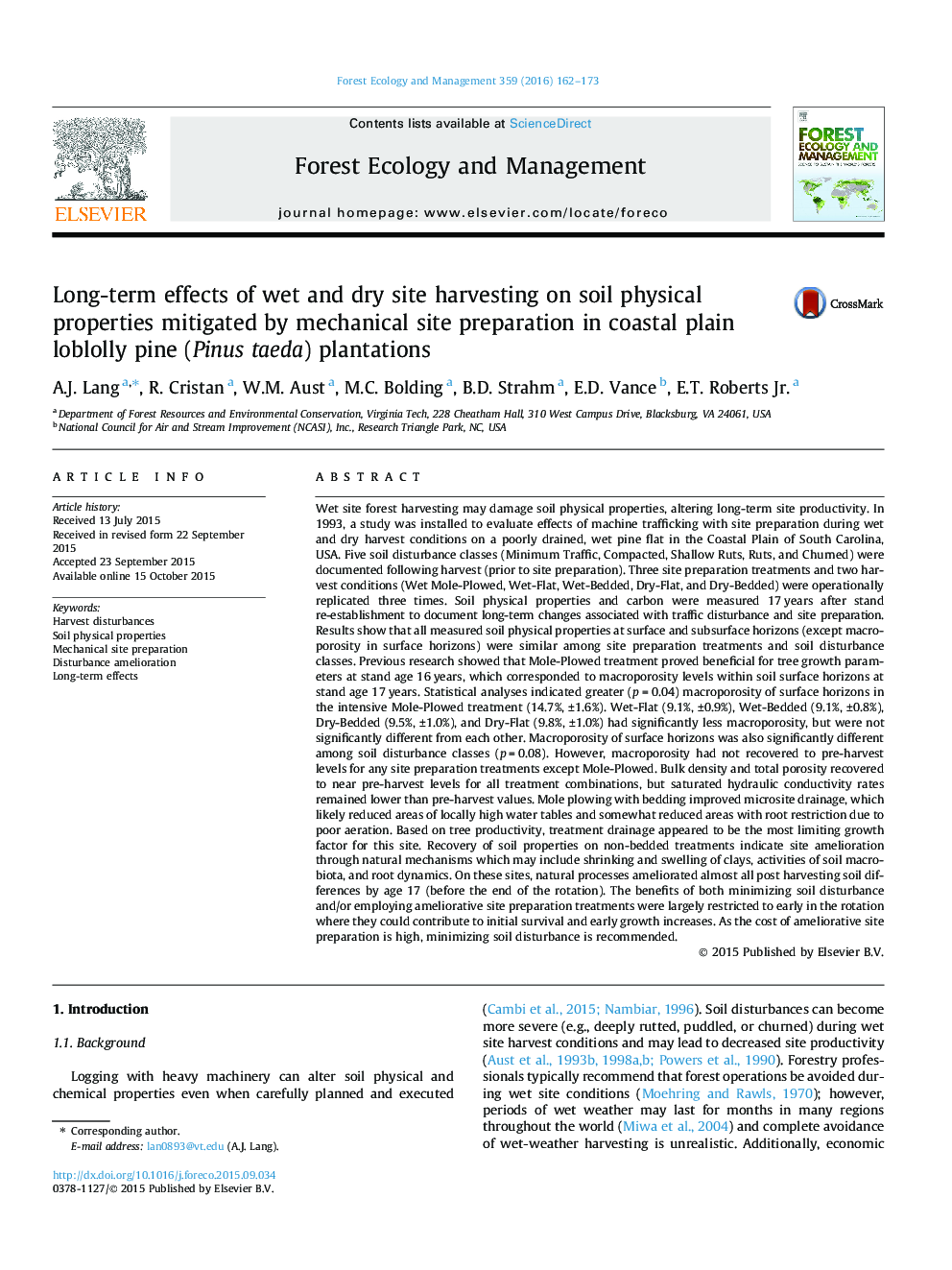| کد مقاله | کد نشریه | سال انتشار | مقاله انگلیسی | نسخه تمام متن |
|---|---|---|---|---|
| 6542653 | 159164 | 2016 | 12 صفحه PDF | دانلود رایگان |
عنوان انگلیسی مقاله ISI
Long-term effects of wet and dry site harvesting on soil physical properties mitigated by mechanical site preparation in coastal plain loblolly pine (Pinus taeda) plantations
دانلود مقاله + سفارش ترجمه
دانلود مقاله ISI انگلیسی
رایگان برای ایرانیان
کلمات کلیدی
موضوعات مرتبط
علوم زیستی و بیوفناوری
علوم کشاورزی و بیولوژیک
بوم شناسی، تکامل، رفتار و سامانه شناسی
پیش نمایش صفحه اول مقاله

چکیده انگلیسی
Wet site forest harvesting may damage soil physical properties, altering long-term site productivity. In 1993, a study was installed to evaluate effects of machine trafficking with site preparation during wet and dry harvest conditions on a poorly drained, wet pine flat in the Coastal Plain of South Carolina, USA. Five soil disturbance classes (Minimum Traffic, Compacted, Shallow Ruts, Ruts, and Churned) were documented following harvest (prior to site preparation). Three site preparation treatments and two harvest conditions (Wet Mole-Plowed, Wet-Flat, Wet-Bedded, Dry-Flat, and Dry-Bedded) were operationally replicated three times. Soil physical properties and carbon were measured 17 years after stand re-establishment to document long-term changes associated with traffic disturbance and site preparation. Results show that all measured soil physical properties at surface and subsurface horizons (except macroporosity in surface horizons) were similar among site preparation treatments and soil disturbance classes. Previous research showed that Mole-Plowed treatment proved beneficial for tree growth parameters at stand age 16 years, which corresponded to macroporosity levels within soil surface horizons at stand age 17 years. Statistical analyses indicated greater (p = 0.04) macroporosity of surface horizons in the intensive Mole-Plowed treatment (14.7%, ±1.6%). Wet-Flat (9.1%, ±0.9%), Wet-Bedded (9.1%, ±0.8%), Dry-Bedded (9.5%, ±1.0%), and Dry-Flat (9.8%, ±1.0%) had significantly less macroporosity, but were not significantly different from each other. Macroporosity of surface horizons was also significantly different among soil disturbance classes (p = 0.08). However, macroporosity had not recovered to pre-harvest levels for any site preparation treatments except Mole-Plowed. Bulk density and total porosity recovered to near pre-harvest levels for all treatment combinations, but saturated hydraulic conductivity rates remained lower than pre-harvest values. Mole plowing with bedding improved microsite drainage, which likely reduced areas of locally high water tables and somewhat reduced areas with root restriction due to poor aeration. Based on tree productivity, treatment drainage appeared to be the most limiting growth factor for this site. Recovery of soil properties on non-bedded treatments indicate site amelioration through natural mechanisms which may include shrinking and swelling of clays, activities of soil macrobiota, and root dynamics. On these sites, natural processes ameliorated almost all post harvesting soil differences by age 17 (before the end of the rotation). The benefits of both minimizing soil disturbance and/or employing ameliorative site preparation treatments were largely restricted to early in the rotation where they could contribute to initial survival and early growth increases. As the cost of ameliorative site preparation is high, minimizing soil disturbance is recommended.
ناشر
Database: Elsevier - ScienceDirect (ساینس دایرکت)
Journal: Forest Ecology and Management - Volume 359, 1 January 2016, Pages 162-173
Journal: Forest Ecology and Management - Volume 359, 1 January 2016, Pages 162-173
نویسندگان
A.J. Lang, R. Cristan, W.M. Aust, M.C. Bolding, B.D. Strahm, E.D. Vance, E.T. Jr.,